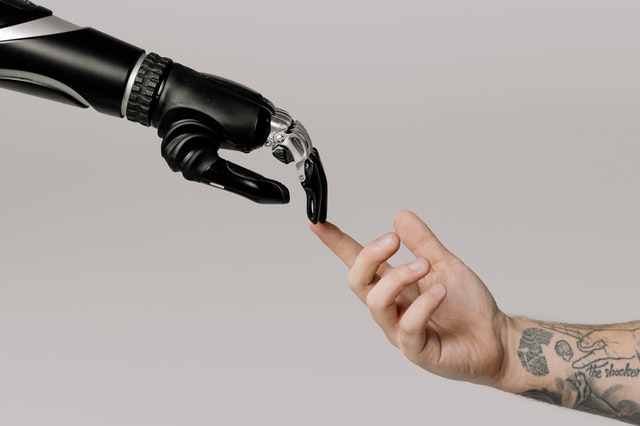What Does AI Really Mean for Your Contact Center?

Sci-fi films and dystopian novels always say that AI will overtake humans in the future. While we’re not there yet, AI is definitely a growing trend in the customer service industry. Is AI overtaking your contact center right now? Is your call center ready to integrate artificial intelligence?
We’re not going to speculate on the fate of humanity vs. AI. But, we’ll try to show you how you can use AI to your advantage at your contact center. Find out what types of AI software is commercially available, and how you can use it effectively.
What Is AI and How Can You Use It in Contact Centers?
AI or artificial intelligence is the concept of intelligent machines. Unlike living beings, computers can’t feel emotions. However, they can think and calculate much faster than humans. That’s why artificial intelligence has the potential to greatly improve people’s lives, and customer service too.
Various AI programs exist to interact with humans as if they were humans themselves. AI software can range from a simple code that responds with set commands to a sophisticated program that can analyze and interpret linguistics to adjust its responses.
As you can see, not all artificial intelligence software is the same. And even in a contact center, there are different types of AI you can use.
Find out which contact center AI suits your business best.
The Self Service Bot
Although these programs aren’t complicated, they’re definitely a smart and innovative way to handle simple customer service requests.
The self-service bot can handle interactions that don’t necessarily need an agent. Setting up appointments, answering basic questions, and distributing information are the self-service bot’s greatest uses.
Getting simple tasks done without the need for a human agent can save companies time and money.
You can find self-service bots in online chats, and even some low-level interactive voice response (IVR) programs over the phone.
Interactive Voice Response (IVR)
IVR has been a great asset to call centers. A robotic greeting voice that can take customer information and direct them to the right place makes every agent’s job easier.
However, not all call centers use IVR technology right. Some set it up to be too long, others don’t rely on it as much as they should.
When you implement an IVR system, make sure you map out the customer’s journey. Don’t let them relay information pre-call that they just have to repeat to the agent. This can lead to increased call time, frustrated customers, and low satisfaction scores.
AI in Contact Center Analytics
Arguably, AI’s greatest strength lies in contact center analytics.
An artificial intelligence program can listen to a conversation and understand what the agent and the customer talk about. What’s more, it can also understand linguistic cues and compile analytics on how the call went overall.
AI can transcribe and analyze conversations, give sentiment scoring, and aid the agent to help solve their problems faster.
The Many Uses of AI in the Contact Center
AI isn’t limited to just chatbots, IVRs, and analytics in a contact center. Discover what NICE CEO Paul Jarman has to say about the many uses of AI in this interview with Expivia CEO Tom Laird on the Call Center Geek podcast:
Google’s Contact Center AI
Google made some headlines back in 2018 with its brand new contact center AI. An artificial intelligence program made an appointment at a hair salon, and the hairdresser had no idea she was talking to a robot.
This is the kind of technology executives think of when they hear artificial intelligence in call centers. Sophisticated technology that is on par with human communication.
But, just because it’s generally available doesn’t mean that it’s generally acceptable yet. Some customers may really dislike talking to AI instead of a human.
Since 2018, Google’s artificial intelligence contact center has only improved. Now offering extensive services to companies, AI is just another avenue where Google’s resources excel.
Google AI Real-Life Call Transcription
Currently, analytics happens after the call. The call gets recorded, then it goes to a server for transcription. Then, it’s sent to another server to analyze the speech patterns and performance. Finally, we receive it with the overall readout of keywords, tone, sentiment, and other key metrics.
Google’s real-life transcription could make this into a streamlined and efficient process.
A supervisor can monitor all calls in real-time. They can help agents in need and ensure that customer service standards are met.
Google AI Call Center Agent Assist
Another great feature of real-time transcription is the AI’s assist function. Agent Assist will give the agent real-time advice on how to service, how to sell, what to say, and when to say it.
For example, when the AI hears the customer say “thank you” it will suggest a way to cross-sell or up-sell a product.
This doesn’t just make the customer service better. It also makes the contact center more profitable. It will help our agents sell and convert more happy customers.

Google AI and Google Translate
There’s only one way to enhance Google’s real-life call transcription feature. And that’s by combining Google Translate with Google AI.
Soon, the technology to instantly translate calls will be widely available. Language will no longer be a barrier between customers and agents.
Will Artificial Intelligence Replace Call Center Agents?
AI seems to be capable of anything. It can think like a human, talk like a human, and in some cases, it even sounds like a human.
This begs the question: will AI replace real-life call center agents?
With IVR and self-service bots being increasingly popular and significantly cheaper, a lot of people would say yes. But, the truth is much different.
Artificial intelligence will never replace real people, yet.
Everyone craves human connection. And we’re not just talking about our distrust of machines. Your customers will be frustrated if they can’t contact a human to resolve their problems.
Any executive that hopes that AI software will just have to appreciate their employees, their customer service skills, and their empathy.

Contact Center Best Practice: AI with Agents
So, you’re saying AI is amazing for contact centers, then you tell us they won’t replace humans? Which one is it?
Well, it’s both.
For the ultimate contact center efficiency and customer satisfaction, you should use real-life agents and AI combined. The software can take some of the weight off your reps’ shoulders, letting them focus on the inquiries that truly require the human touch.
Remember, customer satisfaction should be every contact center’s main focus. And cutting corners won’t guarantee the best results.
The Contact Center That’s Not Afraid to Use AI
The AI revolution in contact centers has already begun. And the use of artificial intelligence will only be more prominent in the future.
Is your call center ready for AI?
At Expivia USA, we’re always looking for the latest technological advancements to implement. We strive for better customer experience, lower overhead costs, and a great work environment.
Artificial intelligence helps with all of that. But, we’re more than aware of how invaluable our agents are to our contact centers.
If you need help with your contact center, you can trust Expivia to deliver the customer service and support you need. Our numbers prove that our method works.
Contact us for more information about us and let’s start a conversation about how we can help your contact center.





Pingback: Advanced Call Center Technologies: Trends and Best Practices | Expivia
Pingback: What Is an Omnichannel Contact Center? | Expivia